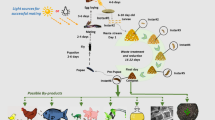Abstract
Vermicomposting of fly ash has been attempted, using red earthworm, Eisenia foetida. Fly ash, which was obtained from thermal power station, was mixed with cowdung in different proportions (20, 40, 60 and 80%). These mixtures were used as feed for earthworms, and after 30 days, vermicast recovery, worm zoomass and numbers of juveniles produced were recorded. A total of six runs each of 30 days were conducted during the whole study. Concentrations of heavy metals in different mixtures of fly ash–cowdung, before and after vermicomposting and in the earthworms used in the study were also estimated. Results show maximum output of vermicasts and maximum number of juveniles produced was in reactors with 40% fly ash while maximum weight gain by earthworm was in 20% fly ash vermireactors. Performance of vermireactors up to 60% fly ash was more or less similar but at 80% fly ash, there is a marked reduction in overall performance of the reactors. Chemical analysis of different samples of fly ash–cowdung mixtures prior to vermicomposting revealed high concentrations of zinc, chromium, lead, nickel and copper. Chemical analysis of vermicomposted samples showed 30–50% reduction in heavy metals up to 60% fly ash and 10–30% reduction in 80% fly ash. Metal analysis of earthworms revealed considerable bioaccumulation of heavy metals in their body. The Present study indicates the feasibility of E. foetida for mitigating the toxicity of metals and up to 60% fly ash–cowdung mixtures can be used for sustainable and efficient vermicomposting.
Similar content being viewed by others
References
Aaseth, J. and Norseth, T.: 1986, ‘Copper’, in L. Friberg, G. F. Nordberg and V. Vouk (eds.), Handbook on the Toxicology of Metals, 2nd edn., Elsevier, Amsterdam, The Netherlands, pp. 233–254.
Abbasi, S. A. and Ramasamy, E. V.: 1999, Biotechnological Methods of Pollution Control, Orient Longman (Universities Press India Ltd.), Hyderabad, 168 pp.
Barrera, I., Andres, P. and Alcaniz, J. M.: 2001, ‘Sewage sludge application on soil: Effects on two earthworms species’, Water Air Soil Pollut. 129, 319–332.
Berman, E.: 1980, ‘Toxic metals and their analysis’, in D. C. Thomas (ed.), Hayden International Topics in Science Series, Hayden, London, 74 pp.
Brun, E. C. H. R., White, L. R. and Eik-Nes, K. B.: 1987, ‘Effects of chromate ions on the membrane of established human cells as measured by uptake of a permeant lipophilic cation’, Toxicol. Lett. 35, 253–259.
Campbell, D. J., Fox, W. E., Aitken, R. L. and Bell, L. C.: 1983, ‘Physical characteristics of sands amended with flyash’, Aust. J. Soils Res. 21, 147–154.
Chang, A. C., Lund, L. J., Page, A. L. and Warneke, J. E.: 1977, ‘Physical properties of fly ash amended soils’, J. Environ. Qual. 6, 267–270.
Giedrojc, B., Fatyga, J. and Hryncewizc, Z.: 1980, ‘The effect of fertilizers with ashes from black coal burned in electric power station on the properties of sandy soils and crops’, Polish J. Soil Sci. 13, 163–171.
Hoodgsen, L., Dyer, D. and Brown, D. A.: 1982, ‘Neutralization and dissolution of high calcium fly ash’, J. Environ. Qual. 11, 93–98.
I.A.R.C.: 1980, ‘Some metals and metallic compounds’, Vol. 23, IARC monographs on the evaluation of carcinogenic risk of chemicals to man, International Agency for Research on Cancer. Lyon, France.
I.A.R.C.: 1987, ‘Overall evaluation of carcinogenecity’, Vol. 1–42, An updating of IARC monographs, International Agency for Research on Cancer, Lyon, France.
I.A.R.C.: 1990, ‘Chromium, nickel and welding’, Vol. 49, IARC monographs on the evaluation of carcinogenic risk of chemicals to man, International Agency for Research on Cancer, Lyon, France.
Ismail, S. A.: 1997, Vermicology: The Biology of Earthworms, Orient Longmans, Hyderabad, 92 pp.
Kuiker, U., Summer, M. E. and Miller, W. P.: 1994, ‘Boron release from fly ash and its uptake by corn’, J. Environ. Qual. 23, 596–603.
Kumar, A. C.: 1994, State of the Art Report on Vermiculture in India, Council for Advancement of Peoples Action and Rural Technology (CAPART), New Delhi, 60 pp.
Lin, H. C., Tseng, L. L., Kuo, S., Su, Y. H. and Chai, M. H.: 1983, ‘Fertilizer characteristics of flyash’, J. Agric. Assoc. China 121, 57–65.
Lobi, F., Kuldva, M. and Petrikova, V.: 1971, ‘Agronomical aspects of the use of pulverized fuel ash: Effects of high rates of ash on the yields of some crops and biochemical changes in the soil’, Roztlina Vyroba 17, 1165–1178.
Mulford, F. R. and Martens, D. C.: 1971, ‘Response of alfalfa to boron in fly ash’, Proc. Soil Sci. Soc. Am. 35, 296–300.
Saxena, M., Chauhan, A. and Ashokan, P.: 1998, ‘Fly ash vermicomposting from non-ecofriendly organic wastes’, Pollut. Res. 17, 5–11.
Scheinberg, H.: 1992, ‘Copper’, in E. Merian (ed.), Metals and their Compounds in Environment, VCH, Verlagsgesellschaft, Weinheim, Germany, pp. 893–907.
Su, D. C. and Wong, J. W. C.: 2002, ‘The growth of corn seedling in alkaline coal fly ash stabilized sewage sludge’, Water Air Soil Pollut. 133, 1–13.
Szczeck, M. M.: 1999, ‘Suppressiveness of vermicompost against fusarium wilt of tomato’, J. Phytopathol. [Phytopathologische Zeitschrift] 47, 155–161.
T.E.R.I.: 1998, ‘Reclaiming ash pond by means of mycorrhizal-organo-biofertilizer’, Quarterly reports submitted to fly ash mission, TIFAC, DST, Tata Energy Research Institute, New Delhi, India.
Author information
Authors and Affiliations
Corresponding author
Rights and permissions
About this article
Cite this article
Gupta, S.K., Tewari, A., Srivastava, R. et al. Potential of Eisenia foetida for Sustainable and Efficient Vermicomposting of Fly Ash. Water Air Soil Pollut 163, 293–302 (2005). https://doi.org/10.1007/s11270-005-0722-y
Received:
Accepted:
Issue Date:
DOI: https://doi.org/10.1007/s11270-005-0722-y




